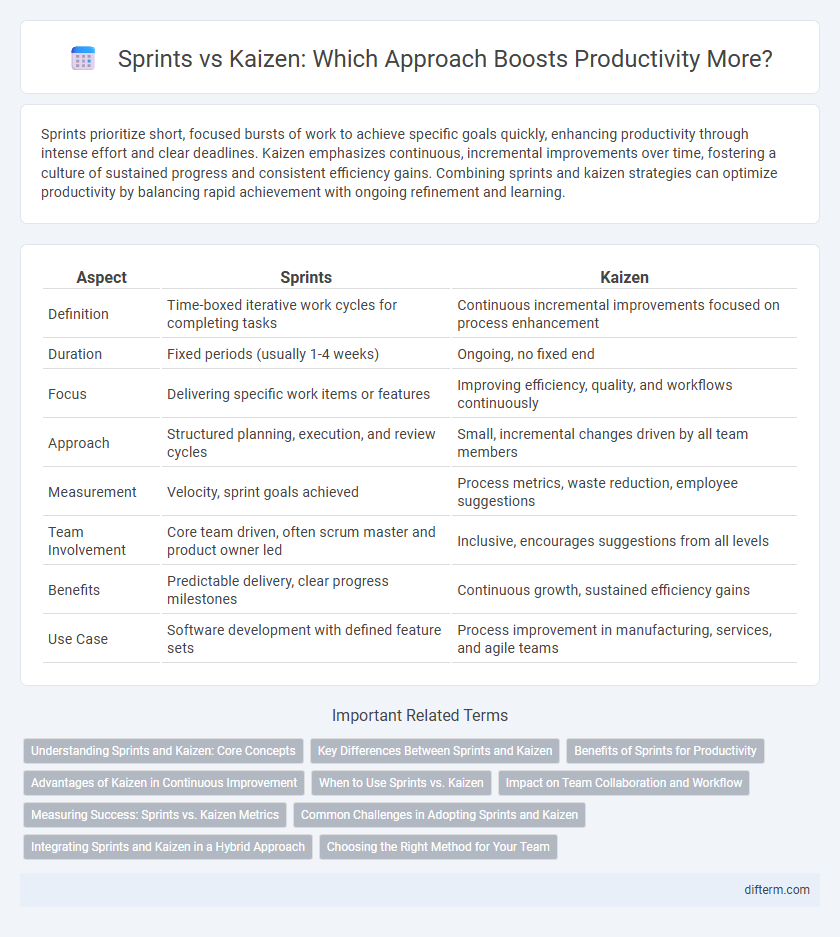Sprints prioritize short, focused bursts of work to achieve specific goals quickly, enhancing productivity through intense effort and clear deadlines. Kaizen emphasizes continuous, incremental improvements over time, fostering a culture of sustained progress and consistent efficiency gains. Combining sprints and kaizen strategies can optimize productivity by balancing rapid achievement with ongoing refinement and learning.
Table of Comparison
| Aspect | Sprints | Kaizen |
|---|---|---|
| Definition | Time-boxed iterative work cycles for completing tasks | Continuous incremental improvements focused on process enhancement |
| Duration | Fixed periods (usually 1-4 weeks) | Ongoing, no fixed end |
| Focus | Delivering specific work items or features | Improving efficiency, quality, and workflows continuously |
| Approach | Structured planning, execution, and review cycles | Small, incremental changes driven by all team members |
| Measurement | Velocity, sprint goals achieved | Process metrics, waste reduction, employee suggestions |
| Team Involvement | Core team driven, often scrum master and product owner led | Inclusive, encourages suggestions from all levels |
| Benefits | Predictable delivery, clear progress milestones | Continuous growth, sustained efficiency gains |
| Use Case | Software development with defined feature sets | Process improvement in manufacturing, services, and agile teams |
Understanding Sprints and Kaizen: Core Concepts
Sprints are structured, time-boxed iterations commonly used in Agile methodologies to achieve specific goals quickly, emphasizing rapid delivery and adaptability. Kaizen focuses on continuous, incremental improvements driven by employee involvement and long-term process optimization. Understanding these core concepts highlights that sprints prioritize short-term efficiency bursts, while Kaizen fosters sustained productivity enhancement through ongoing refinement.
Key Differences Between Sprints and Kaizen
Sprints emphasize short, time-boxed cycles aimed at delivering specific, incremental results within agile frameworks, typically lasting 1 to 4 weeks. Kaizen focuses on continuous, incremental improvements in processes and efficiency through ongoing, small-scale changes without fixed deadlines. The primary difference lies in sprints' goal-oriented bursts of productivity versus Kaizen's emphasis on sustained, gradual enhancement of workplace practices.
Benefits of Sprints for Productivity
Sprints enhance productivity by creating focused, time-bound work periods that drive rapid progress and clear goal achievement. This approach encourages team alignment, reduces procrastination, and facilitates continuous feedback cycles for quick adjustments. The structured nature of sprints increases accountability and momentum, leading to accelerated project completion and measurable productivity gains.
Advantages of Kaizen in Continuous Improvement
Kaizen enhances continuous improvement by fostering a culture of small, incremental changes that lead to sustainable productivity gains over time. Unlike sprints that focus on short-term goals, Kaizen encourages employee involvement at all levels, promoting ongoing problem-solving and innovation. This steady approach minimizes disruptions, improves processes consistently, and builds long-lasting efficiency within organizations.
When to Use Sprints vs. Kaizen
Sprints excel in projects requiring rapid, focused bursts of productivity with clear, time-boxed goals, ideal for software development cycles or product launches. Kaizen suits continuous improvement environments where incremental changes build long-term efficiency and quality, often implemented in manufacturing or operational workflows. Choose sprints for fast-paced, deliverable-driven tasks and Kaizen for evolving processes emphasizing steady progress and employee involvement.
Impact on Team Collaboration and Workflow
Sprints promote focused, time-bound efforts that enhance team collaboration by setting clear goals and deadlines, which drives rapid progress and accountability. Kaizen emphasizes continuous, incremental improvements that foster a culture of ongoing teamwork and adaptability, improving workflow efficiency over time. Combining sprint cycles with Kaizen principles can balance immediate productivity boosts with sustainable process enhancements.
Measuring Success: Sprints vs. Kaizen Metrics
Sprints measure success through defined, time-boxed goals and key performance indicators (KPIs) such as velocity and completed user stories, emphasizing rapid progress and deliverables. Kaizen metrics prioritize continuous improvement by tracking incremental changes, employee engagement, and process cycle times, focusing on long-term efficiency gains. Comparing these approaches reveals sprints drive short-term productivity bursts, while Kaizen fosters sustained operational excellence.
Common Challenges in Adopting Sprints and Kaizen
Common challenges in adopting sprints include resistance to change, limited team collaboration, and difficulty maintaining consistent sprint cycles. Kaizen adoption often faces obstacles such as employee disengagement, lack of continuous improvement culture, and insufficient management support. Both frameworks require clear communication, ongoing training, and strong leadership to overcome these barriers effectively.
Integrating Sprints and Kaizen in a Hybrid Approach
Integrating sprints and Kaizen in a hybrid approach maximizes productivity by combining the time-boxed, goal-oriented focus of sprints with the continuous, incremental improvement mindset of Kaizen. This synergy enables teams to deliver rapid results while fostering ongoing process enhancements and adaptability. Organizations that adopt this balanced methodology often experience sustained efficiency gains and higher-quality outcomes.
Choosing the Right Method for Your Team
Selecting the right productivity approach depends on your team's goals and work style; sprints emphasize structured, time-boxed cycles for delivering focused results, while Kaizen promotes continuous, incremental improvements to processes. Teams aiming for rapid innovation and clear milestones benefit from sprint frameworks like Scrum or Agile, whereas organizations seeking long-term quality enhancement and adaptability thrive with Kaizen's philosophy of ongoing refinement. Evaluating factors such as project complexity, team dynamics, and desired outcome cadence guides optimal method choice for maximizing productivity.
sprints vs kaizen Infographic

 difterm.com
difterm.com